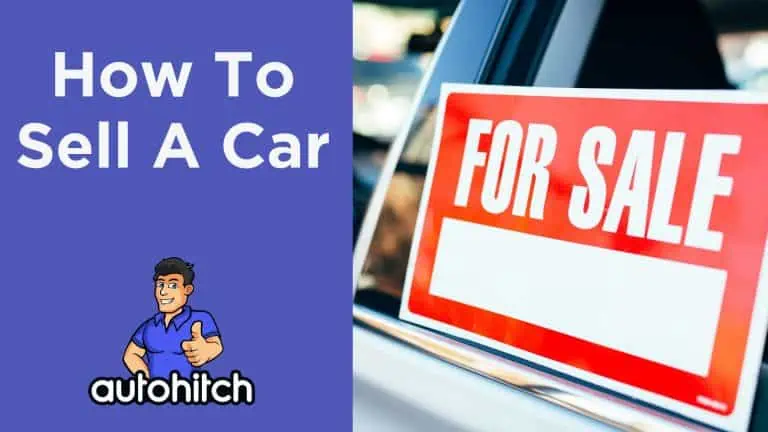Knowing how to sell a car isn’t something you learn overnight; it’s something you have to do for at least a few years before you experience almost everything that can happen along the way.
But thankfully, as a former car dealer, I took the blows and learned the lessons for you!
In this blog post, I’ll guide you through the entire car-selling process, from determining your car’s worth and prepping it for sale to negotiating with potential buyers and finalizing the deal.
Key Takeaways | How To Sell A Car
- There are three main ways to sell a car: trade-in, selling privately, or receiving an instant cash offer from a third-party buyer.
- Necessary documentation for selling a car includes the title, registration, and maintenance records. Keep these documents ready and up-to-date.
- Researching the market value of your vehicle based on its condition and mileage can help set an accurate asking price that attracts potential buyers.
- Preparing your car for sale by cleaning it inside out, making minor repairs, and having comprehensive maintenance records can increase its resale value.
Table of Contents
Different Ways to Sell a Car: A Comprehensive Guide
When it comes to selling your used car, you have several options. Here’s a detailed guide on the different ways to sell a car, each with its own advantages and considerations.
Trade-In: A Convenient Option
Trading in your car at a dealership is a popular method, especially for those looking to purchase a new vehicle simultaneously. Dealerships will assess your car’s value based on factors like condition, age, mileage, and market demand. To get the best trade-in deal, research and compare offers from multiple dealerships. However, keep in mind that you might not get the highest possible price due to the dealership’s need to make a profit.

Sell It Yourself: Maximizing Profit
Selling your car privately can potentially yield the highest return, as you avoid dealership fees. This method requires more effort, including researching your car’s market value, creating an attractive advertisement, and interacting with potential buyers. Always prioritize safety when selling privately, meeting in public places for test drives, and using secure communication channels.
Instant Cash Offer: Quick and Easy
For those looking for a quick and easy sale, an instant cash offer can be a great option. Companies like Kelley Blue Book’s Instant Cash Offer service, CarMax, or Carvana provide immediate, no-obligation quotes. While this method offers convenience and speed, the offer might be lower than what you could get from a private sale or trade-in.
Documents Needed to Sell Your Car
When selling your car, having the necessary paperwork and documentation ready can streamline the process.
Title
The car title is essential to prove ownership. Ensure there are no liens on the vehicle and that all information on the title is accurate. If the title is lost or damaged, you can obtain a new one from your state’s Department of Motor Vehicles (DMV).
Registration
Ensure your registration is up-to-date before selling your car. Some states may require a smog test before you can transfer ownership. After selling your car, remove its license plates and notify the DMV.
Maintenance Records
Gathering maintenance records can demonstrate to potential buyers that the vehicle has been well-maintained, potentially increasing the sales price. These records should include documentation of regular oil changes, tire rotations, and other scheduled maintenance.
Do I need to disclose the car’s mileage?
Yes, you are required by law to disclose the accurate mileage of the car at the time of sale. If the odometer reading is incorrect, the buyer may have a legal claim against you. Make sure to provide an accurate reading to avoid any legal problems.
Setting the Asking Price
Pricing your used car appropriately is a critical step in the selling process. It can mean the difference between a quick sale and your car sitting unsold for months. Here’s a step-by-step guide to help you set the right asking price for your car.
Step 1: Understand Your Car’s Market Value
The first step in pricing your used car is understanding its market value. Websites like Kelley Blue Book or Carvana can provide an estimate of your car’s worth based on factors such as make, model, year, mileage, and overall condition. Remember to be honest about your car’s condition to get a realistic estimate.
Step 2: Research Similar Listings
Look at how similar cars (same make, model, year, condition, and mileage) are priced in your local market. You can check online car-selling platforms, dealership websites, and even Craigslist. This will give you a sense of the price range for cars similar to yours.
Step 3: Consider Your Car’s Unique Features
Does your car have any unique features or upgrades that could increase its value? Things like a sunroof, leather seats, upgraded sound systems, or new tires can make your car more appealing to buyers and justify a higher asking price.
Step 4: Set a Competitive Price
Based on your research, set a competitive asking price for your car. If you price it too high, potential buyers may be put off. If you price it too low, you may not get the return you deserve. A competitive price is one that’s in line with the market but also accounts for what makes your car unique.
Step 5: Leave Room for Negotiation
Most buyers will expect to negotiate the price down a bit, so consider setting your asking price slightly higher than what you’re willing to accept. However, don’t price it too high, as this could deter potential buyers.
Step 6: Be Prepared to Justify Your Price
Buyers may ask why you’ve priced your car the way you have. Be prepared to explain your reasoning, whether it’s the car’s excellent condition, recent maintenance, unique features, or simply its market value.
Preparing Your Vehicle for Sale
When it comes to selling your used car, first impressions matter. A well-prepared car not only attracts more buyers but can also command a higher price. Here’s a step-by-step guide on how to prepare your vehicle for sale.
Step 1: Clean the Interior and Exterior
A clean car is a more attractive car. Start by thoroughly cleaning the interior. Vacuum the carpets, wipe down the dashboard and other surfaces, and clean the windows. For a deeper clean, consider hiring a professional detailer or using a local car wash that offers carpet shampooing. This can help remove any lingering odors and make the car feel fresh and well-cared for.
Next, focus on the exterior. A good wash, wax, and polish can give your car a showroom shine that catches the eye of potential buyers. Don’t forget to clean the wheels and tires for that extra touch.
Step 2: Make Minor Repairs
Minor issues can be a major turn-off for potential buyers. Before listing your car for sale, take the time to address any minor mechanical or cosmetic issues. This could include replacing burnt-out bulbs, fixing windshield cracks, or repairing small dents and scratches.
Remember, buyers may worry that if you’ve neglected these small issues, there could be larger, hidden problems. By addressing these concerns upfront, you can build trust with potential buyers and justify your asking price.
Step 3: Ensure All Systems are Functioning Properly
Before selling your car, make sure all its systems are functioning properly. This includes everything from the brakes and tires to the air conditioning and navigation systems. If any of these systems are not working as they should, consider getting them repaired. While this may require an upfront investment, it can help you get a better price for your car and make the sale process smoother.
Step 4: Gather Maintenance Records
If you’ve kept up with regular maintenance on your car, show it off! Gather your maintenance records to show potential buyers. This can demonstrate that you’ve taken good care of the car and can provide peace of mind to buyers.
The Best Place To Sell A Car
When it comes to selling a used car, effective advertising and knowing the best place to sell your car can make all the difference. Here’s a step-by-step guide on how to advertise your car to attract potential buyers and get the best possible price.
Step 1: Advertise Your Car Online
The best place to sell your car and reach potential buyers is through online listings. Platforms like CarGurus, Autotrader, and Cars.com allow you to reach a wide audience.
When creating your listing, be sure to include all the necessary information about your car, including make, model, year, mileage, condition, and asking price. High-quality photos can also help attract buyers.
Read more on how to sell a car online here.
Step 2: Utilize Social Media
In today’s digital age, social media platforms like Facebook, Twitter, and Instagram can be powerful tools for advertising your car. You can post photos, share details about your car, and engage with potential buyers. Many online marketplaces also offer integrated social media sharing options, further increasing your car’s exposure.
Step 3: Consider Print Ads
While online advertising is increasingly popular, don’t overlook traditional print ads. Local newspapers or auto trader magazines can still be effective, especially for reaching an older demographic.
However, given the shift towards digital platforms, it’s worth considering where your time and money are best spent.
Screening Potential Buyers: Ensuring a Safe and Secure Sale
Selling your car involves more than just advertising. It’s also important to screen potential buyers to ensure a safe and secure transaction.
Step 1: Communicate Via Email or Phone
Establish clear lines of communication with potential buyers. Whether through email or phone, be prepared to provide accurate information about your car and respond to inquiries in a timely manner. This can help build trust with potential buyers.
Step 2: Ask for Identification
Before setting up a test drive, ask potential buyers for identification. This can help prevent fraudulent transactions and ensure your safety. Always request personal identification documents, such as a driver’s license or passport.
Setting Up Test Drives: A Guide to Safe and Effective Test Drives
A test drive can be a crucial part of the car-selling process. Here’s how to set up a test drive that ensures safety and gives potential buyers a good impression of your car.
Step 1: Choose a Safe Location
When setting up a test drive, always choose a safe, public location (Preferably during the day).
Avoid meeting buyers at your home or in secluded areas to reduce the risk of theft or harm. A public parking lot or a busy street can be good options.
Step 2: Accompany the Buyer
During the test drive, accompany the buyer. This allows you to answer any questions they might have and observe how they handle your car. Before the test drive, check your insurance coverage and ask for the buyer’s driver’s license.
Negotiating the Price: A Guide to Effective Price Negotiation
Price negotiation can be a challenging part of the car-selling process. Here’s how to navigate it effectively.
Step 1: Be Prepared With Counteroffers
If a buyer offers a price lower than your asking price, be prepared with counteroffers. Researching the market value of your car can help you determine whether their offer is reasonable.
Step 2: Know Your Bottom Line
Know your bottom line – the minimum price you’re willing to accept for your car. This can help you negotiate effectively and ensure you don’t accept an offer that’s too low.
Finalizing the Sale: Completing the Transaction
Once you’ve found a buyer and agreed on a price, it’s time to finalize the sale.
Step 1: Sign the Title
Signing the title is a crucial step in selling a car. This legal document confirms ownership of the vehicle and must be signed by both the buyer and seller to transfer ownership. Ensure all information on the title is correct, including the VIN number, make and model, year, and mileage.
Step 2: Complete a Bill of Sale
Completing a bill of sale is another essential step. This document serves as legal proof of the sale and transfer of ownership from the seller to the buyer. It typically includes details such as both parties’ information, the vehicle’s make, model, and VIN, as well as any agreed-upon terms and conditions of the sale.
Step 3: Collect Payment
After negotiating a price with the buyer, it’s time to collect payment. There are several options for payment, including cash, certified check, or electronic transfer. It’s important to verify the method of payment and ensure that funds have cleared before you transfer ownership of the vehicle.
Step 4: Cancel Your Insurance and Registration
Once the sale is complete, don’t forget to cancel your insurance and registration. This will protect you from any future liabilities. Also, provide the buyer with a release of liability form for peace of mind on both ends.
By following these steps, you can ensure a smooth and successful car sale. Remember, preparation and clear communication are key to attracting buyers and getting the best price for your car.
FAQ’s
Conclusion
Selling a car can be overwhelming, but it doesn’t have to be. By following the steps outlined in this guide, you can sell your vehicle with confidence and get the most money for it.
Remember to gather all necessary paperwork, determine your car’s worth, prepare it for sale by making minor repairs and cleaning it inside out, and advertise using multiple platforms like social media and online marketplaces.
When screening potential buyers or setting up test drives, always prioritize safety. Be prepared to negotiate on the price while keeping your bottom line in mind.



